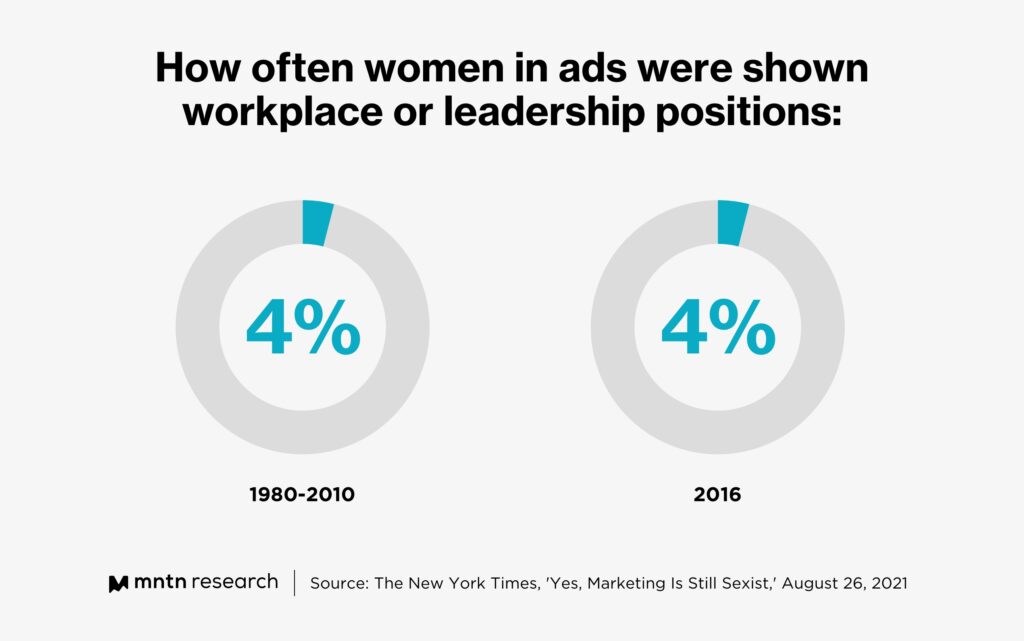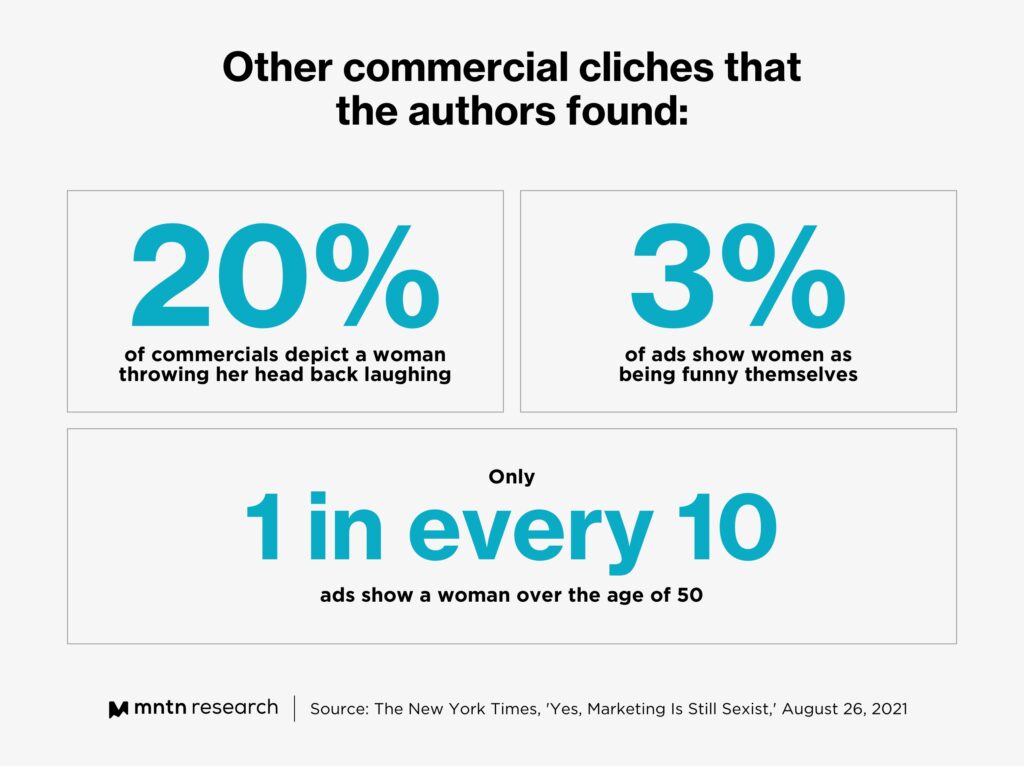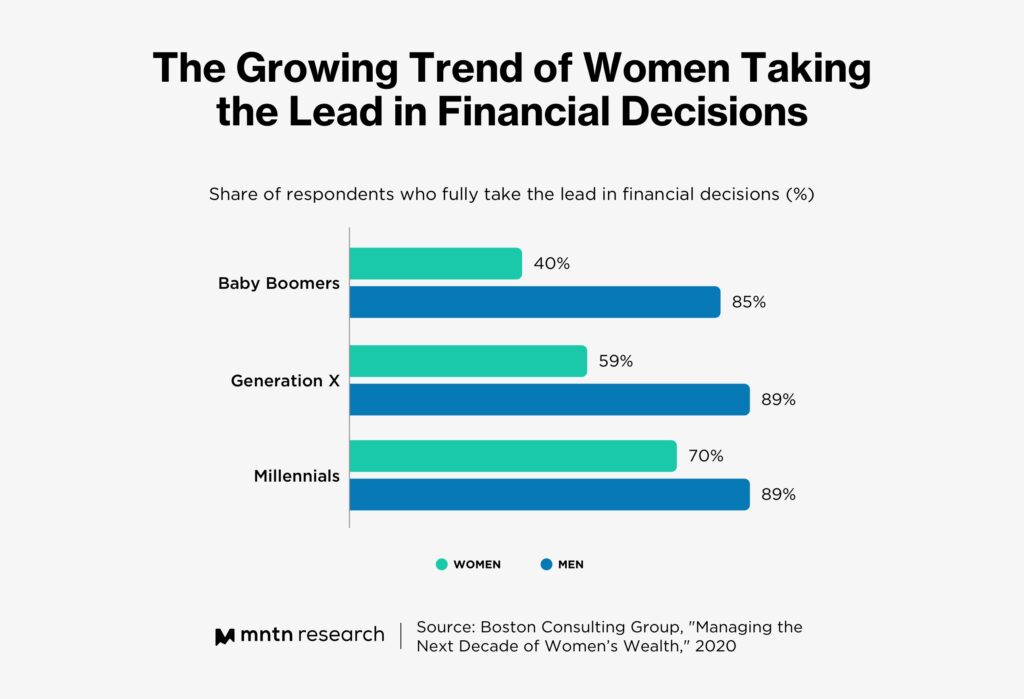Women Are the New Decision Makers – And Advertisers Are Missing Out
by Stephen Graveman7 min read
Abstract
- From Greta Gerwig’s Barbie to Beyoncé, to Taylor Swift’s mega tours, 2023 has cemented the power of female entertainers — and the purchasing power of women
- Women make 90% of the financial decisions in American households, whether they’re partnered or not.
- However, advertisers continue to overlook the power of this audience segment, choosing to stick to outdated clichés and representation
The state of the American woman has transformed radically and repeatedly in a relatively short amount of time, at least by historical standards. A little over 100 years ago, American women couldn’t vote. Before 1974, they couldn’t open a credit card without a male co-signer — even if they out-earned him. And up until this summer, the purchasing power of women was seriously underestimated.
Unfortunately, while women have risen to the role of key decision-makers, advertisers are still lacking in accurate representation and important targeting. But it doesn’t, and shouldn’t, have to be this way.
#BillionGirlSummer
Unless you were living under a rock, you surely noticed that this summer’s billion-dollar pop culture boom was driven by women — and became a viral sensation summed up as #BillionGirlSummer.
Greta Gergwig’s Barbie injected rocket fuel into a flailing box office landscape this summer. Not only did the film, long languishing in Hollywood purgatory, shatter almost every glass ceiling, with Gerwig becoming the first woman director with a billion-dollar movie and the film claiming the biggest-ever opening of a woman-directed feature; it also became a cultural sensation, inspiring a fashion trend (“Barbie-Core”) and permeating the wider zeitgeist, with 90% of Americans having heard of it.
The film is now the highest-grossing movie of 2023, it had the biggest opening weekend of the year, grossing (as of October 3, 2023) over $633.3 million in the Americas and $1.434 billion worldwide.
Taylor Swift’s Eras Tour similarly dominated the zeitgeist this summer, generating long lines, sold-out shows, and cross-country travel for the three-hour, career-spanning event. On the first day of the US presale, Swift fans (dubbed “Swifties”) bought over 2.4 million tickets — the most sold by an artist in a single day (dethroning previous champ Robbie Williams).
Now the tour, which just completed its initial U.S. run, is projected to become the first tour in history to gross as much as $2.2 billion in sales.
For context, the previous record-holder for the highest-grossing tour is Elton John, who earned $939 million for his Farewell Yellow Brick Road Tour — but it took him over five years to do it, from 2018 to 2023. Swift is projected to have surpassed that record in a matter of months, with her shows generating so much tourism and additional revenue that they’ve been compared to a “Super Bowl-level” event in every city.
The same has been said for Beyoncé’s Renaissance World Tour. The tour, the star’s first since 2016, brought with it the “Beyoncé bump” to host cities, and created a boom in tourism so powerful that it may have boosted Sweden’s inflation rate when it kicked off in Stockholm.
On average, fans spent $1,800 to attend the tour, which has likewise broken records, this time as the highest-grossing tour ever for a R&B artist and the biggest tour ever for a Black artist. And despite having a shorter tour than Taylor, Beyonce is still projected to pull in $2.4 billion in gross revenue.
While fans of these three superstar successes know no demographic boundaries (including this author), it was women who came out in full force — and demonstrated just how massive their purchasing power can be. 65% of all Barbie ticket purchasers identify as women, and while there are no statistics on Taylor Swift and Beyoncé ticket buyers, the demographic profile of each’s fanbase is predominantly women and girls.
And while this summer may have cemented the power of women in entertainment, the implications for advertisers — in every industry — go far beyond that.
Why Getting It Right Matters
Like most facets of modern society, advertising hasn’t much-valued women or other groups outside the traditional targets of white men aged 18-35. Jane Cunningham and Philippa Roberts, founders of a marketing consultancy and authors of “Brandsplaining: Why Marketing is (Still) Sexist And How To Fix It,” found that between 1980 and 2010, women in commercials were shown in workplace settings only 4% of the time — and little has changed in the years since.
In fact, a more recent analysis by media consultancy Ebiquity found that of the ads aired in 2016, the same percentage of women were shown in leadership positions of any kind: 4%.

Cunningham and Roberts argue that despite the progress that women have made, they’re still consistently cast in secondary roles in advertisements. “The majority of brands still speak to women from a male perspective, explaining to them what they are and telling what they can be,” they write.
And with young women being bombarded with as many as 10,000 messages a day from brands, this can have dangerous implications for their development — and steep repercussions for brands looking, and failing, to make an impact with this audience.

Putting aside obvious ethical concerns, this is a major missed opportunity for brands from a financial growth standpoint. When modern women can’t see themselves in a brand’s ads, that brand has limited its potential reach — whether or not women are its main audience.
Because women aren’t just outlearning — and in some cities, even outearning — men. They’re increasingly the key decision-makers of the household (long gone are the days of salespeople asking for the “man of the household”).
In fact, women currently make 90% of the financial decisions in American households, whether they’re partnered or not. They also invest over 90% of their assets and earnings back into their families — which means they’re buying not just for themselves but also on behalf of family members. According to a 2020 survey and analysis conducted by Boston Consulting Group, the women of younger generations in heterosexual households are making more of the financial decisions than their older counterparts. It also projects that women’s wealth accumulation will outpace global economic wealth growth in the coming years — all of which points to the trend of women’s financial power continuing in the years and decades ahead.

Targeting the Decision-Makers
In short, if brands want to connect with the most influential consumers, they need to connect with women. But this requires more than just inclusive creative and authentic messaging — it also means actually seeking out these audiences.
In decades past, the (few) advertisers that actually reached out to women relied on that era’s stereotypes to do so. When most women were not in the workforce, kitchen/cleaning/laundry brands would target mothers during the workday, on shows that were known to have a higher female audience (e.g., daytime soap operas).
Today’s audiences are much more nuanced. Countless genres traditionally assigned to men — sports, science fiction, superheroes, action movies — are now enjoyed by all segments of the populace. In fact, when you think of the audience for video games, you might be forgiven for imagining a teenage boy — but the average gamer is 35 years old, and almost half are women.
The diversification of these audiences has made digital channels that allow sharper targeting precision more important than ever. Targeting allows brands to reach key decision-makers regardless of what content they consume, rather than relying on assumptions and stereotypes.
Channels like Connected TV can even follow these audiences from channel to channel — and then track engagement and conversions after they watch an ad, regardless of the device used.
To Succeed, Brands Must Acknowledge Women’s Financial Power
If this summer’s billion-dollar events prove anything, it’s that ignoring the buying power and influence of women isn’t just unwise — at this point, it’s downright self-sabotaging. While women have only just started to chip away at the glass ceiling at work, their financial decision-making at home cannot be denied, and their representation in modern advertising is woefully underprepared to meet that reality.
Advertisers’ responsibility to be thoughtful in how they represent and interact with these audiences isn’t just moral; it’s financial, too. This audience segment isn’t going anywhere — and is only getting stronger.
Subscribe to the MNTN Research Weekly
Sign up to receive a weekly feed of curated research, sent straight to your inbox.
Resources
1 How Three Female Artists Lead This Summer's Billion-Dollar Pop Culture Revival (NPR)
2 Why People Are Dressing Up to See 'Barbie' in Theaters (Yahoo! )
4 Barbie (film) (Wikipedia)
5 First on CNN: Taylor Swift’s Eras tour could become the highest grossing tour of all time (CNN)
6 Elton John’s Farewell Tour Comes to an End With $939 Million and 6 Million Tickets (Billboard)
7 Yelp Coins the ‘Beyoncé Bump’ for the Economic Halo Created by the Pop Star’s Renaissance Tour (Yahoo!)
8 ‘Bills, Bills, Bills': Beyonce Tour May Have Boosted Swedish Inflation (The Wrap)
10 'Beyonce 's 'RENAISSANCE World Tour' is Now the Highest-Grossing Tour by a Black Artist in History, Surpassing Her Own 'Formation World Tour' (Chart Data, X)
11 Beyoncé’s Tour on Pace to Outsell Taylor Swift’s Tour (Yahoo!)
13 Demographic Profile of Taylor Swift Fans in the United States as of March 2023, by Gender (Statista)
14 Beyhive; the Demographics of Beyoncé’s Community (Beyoncé (fan site))
15 From Below the Glass Ceiling: Female Perspectives in the World of Advertising (Taylor & Francis Online)
16 Yes, Marketing Is Still Sexist (The New York Times)
17 How Many Ads Do You See in One Day? (Red Crow Marketing, Inc. )
18 What's Behind the Growing Gap Between Men and Women in College Completion? (Pew Research Center)
19 Young Women Are Out-Earning Young Men in Several U.S. Cities (Pew Research Center)
20 How Women Can Change The World With Their Money Choices (Forbes)
21 Managing the Next Decade of Women’s Wealth (Boston Consulting Group)
22 Gamer Demographics: Facts and Stats About the Most Popular Hobby in the World (DataProt)